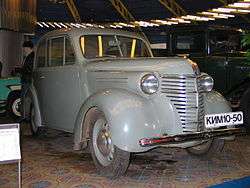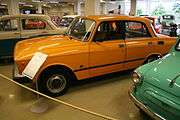Moskvitch
|
| |
.jpg) Abandoned Moskvitch headquarters | |
| Government-owned (1929-1991), privately owned (1991-2010) | |
| Industry | Automotive |
| Fate |
Bankrupt since 2002 Dissolved in 2006 |
| Predecessor | AZLK |
| Successor | None. Partial recuperation of former production factories by Avtoframos (Russian subsidiary of Renault) since 2008 |
| Founded | 1929 |
| Headquarters | Moscow, Russia |
| Products | cars, SUVs, pickup trucks, sports vehicles, vans |
| Website | Official OAO "Moskvich" Website |
Moskvitch (Russian: Москвич) (also written as Moskvich, Moskvič or Moskwitsch) was a Soviet/Russian automobile brand produced by AZLK from 1946 to 1991 and by OAO Moskvitch from 1991 to 2001. The current article incorporates information about both the brand and the joint-stock successor of AZLK for the sake of simplicity.
OAO Moskvitch was a privatized venture name given to the former factory in order to avoid legal issues after the dissolution of the Soviet Union in 1991. Since the factory had no assembly branches outside Russia after 1991, its name is largely used today to refer to the building located in the lower eastern part of Moscow and abandoned since 2006.
The word moskvich (Russian: москвич) itself translates as "a native of Moscow, a Moscower". It was used to point out the original location of the cars manufactured in the capital of Russia, Moscow.
History
In 1929 the construction of Moscow Automotive Plant began with initial production of 24,000 vehicles. Between 1940 and 1941, it built the two-door compact car KIM 10-50 and its "Phaeton" version KIM 10-51. In 1941, after having produced less than 1,000 units, the plant was evacuated to Ural and the entire production converted for the manufacture of military equipment after Hitler's invasion during World War II. After the war, the production of the KIM cars was not resumed, and instead the Soviet Union acquired an Opel manufacturing line from Brandenburg in Soviet occupation zone of Germany to manufacture the modified Opel Kadett under the name Moskvitch-400 in December 1946.[1] In the 1950s and afterwards the factory, now called MZMA (Moskovsky Zavod Malolitrazhnykh Avtomobiley, that is, Moscow Compact Car Factory), replaced it with its own cars developed by Soviet engineers: the second post-war generation consisting of the Moskvitch-402–407 and 410, then by the more advanced Moskvitch 408, 412 and 2140. The M-407 was the first Soviet automotive export to be truly successful in the West.[2] Up to half of all M-407 production was exported for a number of years, mainly to the Eastern Bloc countries, Norway, Finland, and France.[3] Later models also proved a good value in Great Britain, Finland, and Norway, for instance, and in 1968, 55% of production was for export.[4] In 1969, the factory changed its name to AZLK (Avtomobilny Zavod imeni Leninskogo Komsomola, which means Automobile Factory in honor of Komsomol Leninist Communist Youth Union).
Moskvitch cars were sturdy, reliable on substandard roads and were offered at an affordable price. The 1960s and early 1970s were the glory days, when the cars were exported to many countries throughout the world. Demand always exceeded production, so people had to wait a long time for a new car. Until the 1980s all Moskvitch cars were compact rear-wheel drive saloons and estates with solid rear axles suspended by leaf springs.
The Moskvitch was also produced in Bulgaria (see Moskvitch (Bulgaria)) between 1966 and 1990 on the basis of complete knock down (CKD) kits. Models 408, 408I, 412, 21412 "Aleko", total of 304,297 cars.
1986 saw the unveiling of a completely new model, known as the Moskvitch-2141 Aleko, which was often upgraded and restyled during the period of its production. It was powered by the 1.5L UZAM used in 412 model and VAZ-2106 1.6L in-line four-cylinder engines, which had by then amassed an acceptable track record powering a number of LADA models. Aleko was different from any model the factory had made previously: it was larger and more luxurious, made with comfort, safety and aerodynamics in mind. The new car had such innovative features as front-wheel drive, a hatchback body style, MacPherson strut front suspension and torsion-crank rear suspension. It had rack-and-pinion steering and a collapsible steering column. The 1.8 liter gasoline engine for the new car was planned, but never materialized, as was also the case with a diesel version. In the early 1990s AZLK still remained one of the largest auto companies in the USSR. Design and experimental work was prepared to create a new model car (sedan M-2142) and an engine plant. However, after the dissolution of the Soviet Union, due to a financial crisis, disruptions in the work of the company and financial mismanagement the engine plant was not finished and the Moskvitch company fell into decline. Because of its location, Moskvitch was in a more vulnerable position than companies located in other regions, as the cost of living and car production in Moscow began to grow rapidly.
The factory, which had been renamed to OAO Moskvitch (Moskvitch Joint-Stock Company) in the early 1990s, filed for bankruptcy in 2002 and ceased production. Unfinished bodyshells remained on the production line in various stages of completion, while furniture, computers, office supplies, and documents remained in the plant's administration building. Several attempts to restart production have been made over the next 3 years, but none were successful.
Recently, a portion of the abandoned plant was acquired by OAO Avtoframos, a 38%-62% joint venture between the City of Moscow and French automaker Renault SA. In 2005, Avtoframos commenced assembly of Renault Logan sedans from imported complete knock-down kits (CKDs). The presence of Avtoframos brought new life to a small part of the facility, but the majority of the sprawling plant remains abandoned, apparently still owned by the dormant Moskvitch company.
The bankruptcy of OAO Moskvitch was officially announced in 2006 and the company was liquidated the following year.
Since 2009, the owner of the brand Moskvitch is the German automotive company Volkswagen. In 2011, the company extended its brand ownership rights until 2021, a 10-year period.
Generations
First (1940—1956)


- KIM 10-50 (1940-1941) 2-door compact car
- KIM 10-51 (1941) the same car with a Phaeton body
- Moskvitch 400-420 Flathead engine 23 hp (1946-1954)
- Moskvitch 400-420A (4-door convertible, was priced below closed models, but anyway was not popular) (1949–52)
- Moskvitch 400-420B (version of 400 for disabled persons)
- Moskvitch 400-420K (cab-chassis version of 400)
- Moskvitch 400-420M (medical sedan version of 400)
- Moskvitch 400-421 (five-door version of 400-422)
- Moskvitch 400-422 ("woodie" station wagon version of 400) (1949)
- Moskvitch 400-424E (redesigned 400)
- Moskvitch 401-420 Flathead engine 26 hp (1954-1956)
- Moskvitch 401-420B (invalid car version of 401)
- Moskvitch 401-420K (cab-chassis version of 401)
- Moskvitch 401-420M (medical sedan version of 401)
- Moskvitch 401-422 ("woodie" station wagon version of 401) (1954)
Second (1956—1965)
- Moskvitch-402
 Moskvitch-407 with late-version eggcrate grille
Moskvitch-407 with late-version eggcrate grille- Moskvitch-423, the first Soviet non-woodie station wagon
- Moskvitch 402 (with modified Opel flathead engine 35 hp) (1956-1958)
- Moskvitch A9 (minivan prototype, based on 402) (1957)
- Moskvitch 410 (four wheel drive version of 402) (1957-1958)
- Moskvitch 423 (station wagon version of 402) (1957-1958)
- Moskvitch 429 (two-door delivery van prototype, based on 402)
- Moskvitch 430 (two-door delivery van version of 423) (1958)
- Moskvitch 410N (four wheel drive version of 407) (1958-1961)
- Moskvitch 411 (station wagon version of 410) (1958-1961)
- Moskvitch 423N (station wagon version of 407) (1958-1963)
- Moskvitch 407 (45 hp OHV engine) (1958-1964)
- Moskvitch 431 (delivery van prototype, based on 410N)
- Moskvitch 403 (45 hp OHV engine) (1962-1965)
- Moskvitch 424 (station wagon version of 403) (1963-1965)
- Moskvitch 432 (delivery van version of 403) (1964)
Third (1965—1986)
.jpg) Moskvitch-408
Moskvitch-408- Moskvitch-412 from the late 1960s and early 1970s
.jpg) Moskvitch-2138/40
Moskvitch-2138/40
- Moskvitch 408 OHV 50 PS (37 kW; 49 hp), modified 1360 cc 407-engine (1964-1975)
- Moskvitch 408-Tourist (convertible prototype, based on 408) (1964)
- Moskvitch 433 (panel van version of 408) (1966-1975)
- Moskvitch 412 (1967-1975) (latterly known as a Moskvitch 1500 for the Western export market)
- Moskvitch 426 (station wagon version of 408) (1967-1975)
- Moskvitch 427 (station wagon version of 412) (1967-1975)
- Moskvitch 434 (panel van version of 412) (1967-1975)
- Moskvitch-2140 (1976-1988) (carried on the scheme of using the Moskvitch 1500 name for Western exports)
- Moskvitch 2136 (similar to 2137, but with 408 engine) (1976)
- Moskvitch 2137 (station wagon version of 2140) (1976-1988)
- Moskvitch 2734 (panel van version of 2140) (1976-1981)
- Moskvitch 2138 (similar to 2140, but with 408 engine) (1976-1982)
- Moskvitch 2140SL (1981-1986, also known as 1500SL) (improved 2140, Super Lux was made for foreign markets)
- Moskvitch 2733 (panel van version of 2136)
- "Bolivar" (tow truck prototype, based on 2140)
Fourth (1986–2003)
_(15805415925).jpg) Moskvitch-2141
Moskvitch-2141 Moskvitch-2901
Moskvitch-2901 Moskvitch-2142 with sedan body (prototype)
Moskvitch-2142 with sedan body (prototype)-2142.jpg) Moskvitch-2142R5
Moskvitch-2142R5- Moskvitch Svyatogor
- Moskvitch 2141 Aleko (1986)
- Moskvitch 2142 (1997)
- Moskvitch 2143 (1991, prototype)
- Moskvitch 2144 (1985, prototype)
- Moskvitch 2335 (1993, pickup truck based on 2141)
- Moskvitch 2336 (cab-chassis truck based on 2141)
- Moskvitch 2340 (all wheel drive version of 2335)
- Moskvitch 2344 (2000, front-drive version of 2335)
- Moskvitch 2901 (1994, van version of 2141)
- Moskvitch 2141 Moskvitch Sviatogor (1997) (a name taken from the Russian mythology)
- Moskvitch 2142 Dolgorukiy (1997) (named after Yuri Dolgorukiy, founder of Moscow)
- Moskvitch 2142 Kalita (1998) (named after Ivan Kalita, a 14th-century Russian prince)
- Moskvitch 2142 Kniaz Vladimir (1998) (named after Prince Vladimir)
- Moskvitch 2142 Duet (1999)
Sport and racing cars
- Moskvitch 404 Sport (1950s)
- Moskvitch 409 (1962)
- Moskvitch 412R (1972)
- Moskvitch 2141KR (1988)
- Moskvitch G1 (1955)
- Moskvitch G2 (1956)
- Moskvitch G3 (1961)
- Moskvitch G4 (1963)
- Moskvitch G5 (1965)
Prototypes
 Moskvitch-2150 (1973)
Moskvitch-2150 (1973) Moskvitch 3-5-6 (1975)
Moskvitch 3-5-6 (1975)- Moskvitch S1 (1975)
- Moskvitch-2144 Istra (1985)
- Moskvitch 444 (1956-1958, later built as the ZAZ-965)
- Moskvitch 4x4 (1958)
- Moskvitch 415 (1959)
- Moskvitch 415S (1966, improved 415)
- Moskvitch 416 (1960, hardtop version of 415)
- Moskvitch 2148 (1973)
- Moskvitch 2150 (1973)
- 3-5 Series
- Moskvitch 3-5-2 (1970, based on the M-408)
- Moskvitch 3-5-3 (station wagon version of 3-5-2)
- Moskvitch 3-5-4 (modernized 3-5-2)
- Moskvitch 3-5-5 (1972, based on the 3-5-2)
- Moskvitch 3-5-6 (1975)
- C Series
- Moskvitch Delta
- Moskvitch S1 (1975)
- Moskvitch S2 (developed from the S1)
- Moskvitch S3 (1976)
- Moskvitch S4
- Moskvitch 2143 Yauza (1991)
- Moskvitch 2144 Istra (1985)
- Moskvitch X1
Gallery
 Moskvitch-400
Moskvitch-400- Moskvitch-402
 Moskvitch-403
Moskvitch-403- Moskvitch-423
.jpg) Moskvitch-408
Moskvitch-408- Moskvitch-412
- 1972 Moskvitch-427 estate (this year of this export model sold as a Moskvitch-1500)
- Moskvitch-2137
.jpg) Moskvitch-2140
Moskvitch-2140 Moskvitch-2140SL
Moskvitch-2140SL.jpg) M-2141 alias M-2141S
M-2141 alias M-2141S_(15620005108).jpg) M-21412 alias M-2141S
M-21412 alias M-2141S
See also
References
- ↑ German Historical Museum
- ↑ Thompson, Andy. Cars of the Soviet Union (Haynes Publishing, Somerset, UK, 2008), p. 87.
- ↑ Thompson, p. 87.
- ↑ Thompson, p. 144.
External links
| Wikimedia Commons has media related to Moskvich vehicles. |
- http://www.azlk.ru (in Russian, official factory website)
- http://alekohistory.narod.ru (in Russian, dedicated to Aleko-141)
- http://www.moskvich.de
- http://www.moskvichtuning.ru (tuning fan site)
- https://azlk-team.ru (in Russian, fan site)